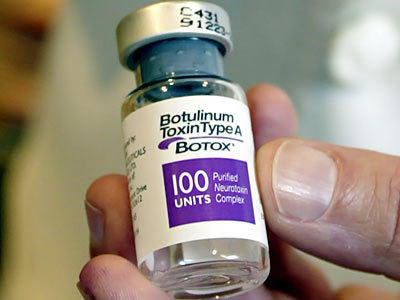While the primary indication of Botox remain the treatment of expression wrinkles, new uses for the drug continue to surface. Local injections of botulinum toxin may significantly benefit patients with headache, spasticity, dystonia, torticollis, hemifacial spasm, blepharospasm, meige syndrome, spastic dysphonia, writer cramp, hyperhydrosis, or tremor. It is even being used with some success according to a report from the University of Pittsburgh, in bladder dysfunction where it has been injected directly into the bladder or urether. The patients suffered from a variety of conditions, including multiple sclerosis, spinal cord injury and stroke.
 Botulinum Toxin Type A is a protein produced by the bacterium Clostridium botulinum. When used in medical settings, small doses of the toxin are injected into the affected muscles and block the release of a chemical acetylcholine that signals the muscle to contract. The toxin thus paralyzes or weakens the injected muscle.
Botulinum Toxin Type A is a protein produced by the bacterium Clostridium botulinum. When used in medical settings, small doses of the toxin are injected into the affected muscles and block the release of a chemical acetylcholine that signals the muscle to contract. The toxin thus paralyzes or weakens the injected muscle.
Botox was first approved in December 1989, to treat two eye muscle disorders (blepharospasm and strabismus) and in December 2000 to treat cervical dystonia, a neurological movement disorder causing severe neck and shoulder contractions. A Canadian ophthalmologist noted a side benefit of wrinkle reduction while treating blepharospasm and the cosmetic use of the drug very quickly became widespred.
It should be stressed that Botox only works to reduce lines of expression and is not beneficial for lines at rest. In other words facial lines that result simply from age, smoking or sun damage are not improved with botox. While used mostly for lines in the forehead and around the eyes, Botox is also effectively used for expressive lip lines and some neck bands. Cosmetic uses of Botox are not specifically approved by the Food & Drug Administration, but represent what is called “off label” use of an approved drug or device. This is based upon the FDA’s recognition that physicians often use their knowledge and discretion in using drugs or devices for indications that may differ from those approved by the FDA.
FDA recently announced the approval of Botulinum Toxin Type A (Botox Cosmetic) to temporarily improve the appearance of moderate to severe frown lines between the eyebrows (glabellar lines). The product’s manufacturer, Allergan, Inc., Irvine, California, is now allowed to market Botulinum Toxin Type A for this new indication. All other cosmetic uses remain “unapproved”. The same is true for most of the other new uses for Botox – specifically headache.
Botox injections may be useful in the treatment of migrane. A chance finding in the aftermath of cosmetic surgery may lead to a cure for as many as 80% of patients suffering from mirgrane. Specifically, doctors from Case Western Reserve University, in Cleveland, Ohio, have discovered a strong correlation between the removal of the corrugator supercilii muscle (a muscle used in frowning) and the elimination or significant improvement of migraine headaches. After checking with a number of patients who had previously had the operation, the doctors discovered that about 40 of these patients had been experiencing migraine types symptoms. Almost 80 percent of the patient said it that their symptoms had been relieved after surgery.
During this operation, muscles that are responsible for frowning and wrinkling of the forehead are deliberately cut to help prevent forehead wrinkles. Interestingly, these are the same muscles that are commonly treated when Botox injections are used to reduce hyperactivity of the forehead.
They then reviewed a number of patients who had been treated with Botox injections. They found similar results. Again, about 80 percent of the patients who had been experiencing migraine types symptoms responded to the injections in that they reported a decrease in migrane symptoms.
Obviously, this is only a preliminary report. At the Facial Plastic & Cosmetic Surgical Center in Abilene, we have also had experience with several patients who have reported that headached symptoms were decreased in frequency or severity following Botox injections.
While encouraging, patients should recognize that very often, early reports of this nature do not pan out in the long run. What makes this treatment so attractive, however, is the fact that Botox injections appear to be extremely safe. At the present time, injections cannot specifically be recommended for the treatment of migraine. However, patients who are considering injections for cosmetic purposes might be more encouraged to give it a try if they are also experiencing migraine type headache syndrome. Botox treatments generally give 3 to 6 months of relief of muscle hyperactivity. Obviously, one could not expect the relief of migrane to last longer than that.
At a recent gathering of the American Headache Society, presenters released findings of 13 studies that indicate Botox rid a number of patients of severe headaches. Doctors who participated in the studies said they were encouraged about the relatively few risks of using Botox to curb headache pain.
“The biggest advantage to Botox is its lack of side effects, especially compared to other medications,” Dr. William Ondo of the Baylor College of Medicine said in an AHS press release. “It really is extremely safe and appears to be very effective for some people.”
More than half of the 48 patients in a study at a Mayo Clinic in Scottsdale, Arizona, said their migraine occurrences and severity dropped by 30 to 60 percent.
At the Baylor College of Medicine Headache Clinic, 58 patients participated in a controlled trial. Some received Botox and others had placebos (water injections). After three months, 55 percent of the patients who received Botox reported at least moderate improvement in their headaches. Only two of the 29 who got the placebo reported relief.


